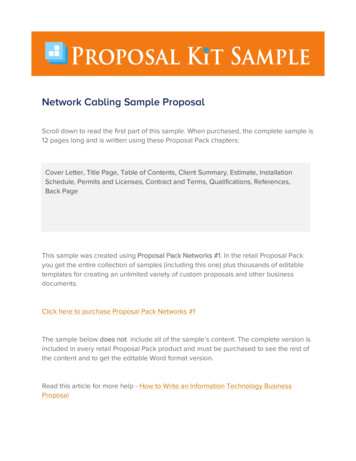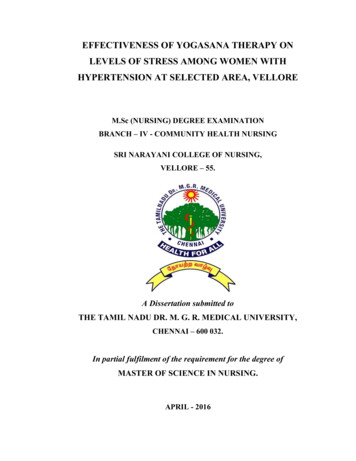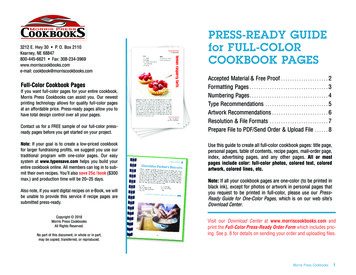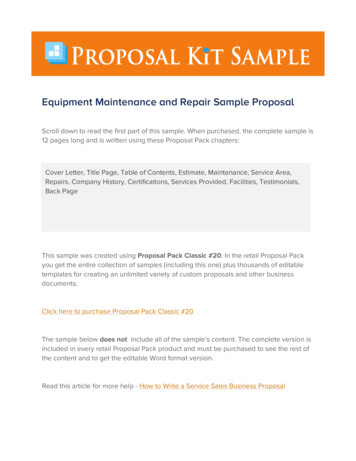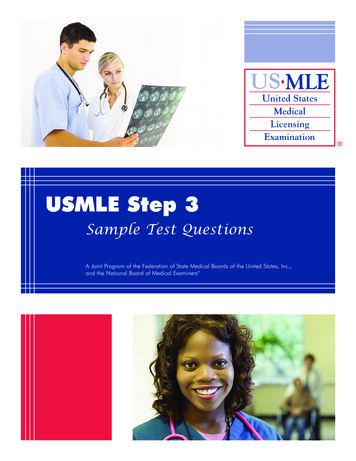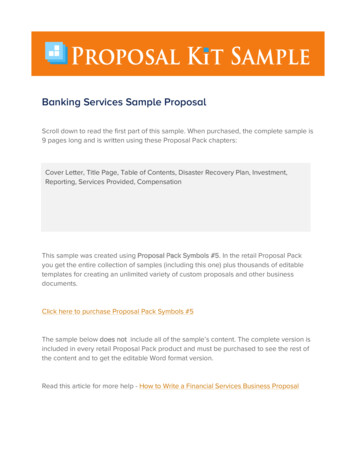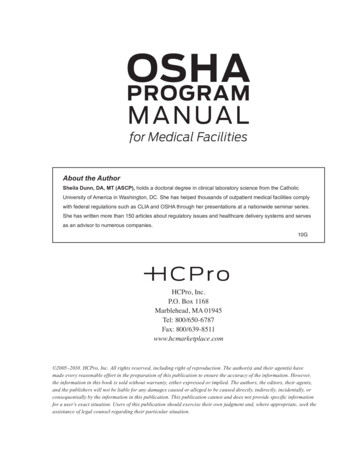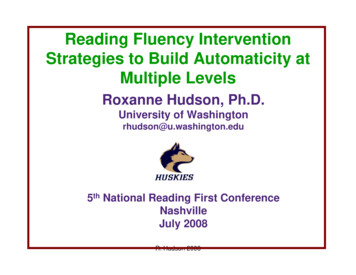
Transcription
Sample Pages – Levels A, B, C, and DHigh Noon Books Novato, California
Available from High Noon BooksHigh Noon Reading Fluency ProgramLevel A (Order #8315-3)Level B (Order #8316-1)Level C (Order #8317-X)Level D (Order 1-57128-317-X1-57128-318-8Cover design by Jill ZwickyInterior design by Bonni GatterCopyright 2004, by High Noon Books. All rights reserved. Printed in the United States of America. No partof this publication may be reproduced, stored in a retrieval system, or transmitted, in any form or by anymeans, electronic, mechanical photocopying, recording or otherwise, without the prior written permission ofthe publisher, unless otherwise indicated.21098765430987654321HIGH NOON BOOKSA Division of Academic Therapy Publications20 Commercial BoulevardNovato, California 94949-6191800 422-7249www.HighNoonBooks.comInternational Standard Book Number 1-57128-315-3Order No. 8315-3
TABLELEVEL AOF CONTENTSIntroduction . . . . . . . . . . . . . . . . . . . . . . . . . . . . . . . . . . . . . . . . . . . . .4Program Features . . . . . . . . . . . . . . . . . . . . . . . . . . . . . . . . . . . . . . . . . .4Using High Noon Reading Fluency . . . . . . . . . . . . . . . . . . . . . . . . . . . .4Timed Reading Options . . . . . . . . . . . . . . . . . . . . . . . . . . . . . . . . . . . . .6Using the Writer’s Corner . . . . . . . . . . . . . . . . . . . . . . . . . . . . . . . . . . .7Exercise 1 Rain . . . . . . . . . . . . . . . . . . . . . . . . . . . . . . . . . . . . . . . . .9Exercise 2 The Sale . . . . . . . . . . . . . . . . . . . . . . . . . . . . . . . . . . . . .10Exercise 3 Roads . . . . . . . . . . . . . . . . . . . . . . . . . . . . . . . . . . . . . . .11Exercise 4 The Doghouse . . . . . . . . . . . . . . . . . . . . . . . . . . . . . . . . .12Exercise 5 Rice . . . . . . . . . . . . . . . . . . . . . . . . . . . . . . . . . . . . . . . .13Exercise 6 The Fireplace . . . . . . . . . . . . . . . . . . . . . . . . . . . . . . . . .14Exercise 7 Goats . . . . . . . . . . . . . . . . . . . . . . . . . . . . . . . . . . . . . . .15Exercise 8 The Trunk . . . . . . . . . . . . . . . . . . . . . . . . . . . . . . . . . . . .16Exercise 9 Plants . . . . . . . . . . . . . . . . . . . . . . . . . . . . . . . . . . . . . . .17Exercise 10 Jeans . . . . . . . . . . . . . . . . . . . . . . . . . . . . . . . . . . . . . . . .18Exercise 11 Coal . . . . . . . . . . . . . . . . . . . . . . . . . . . . . . . . . . . . . . . .19Exercise 12 Nell Green . . . . . . . . . . . . . . . . . . . . . . . . . . . . . . . . . . .20Exercise 13 Black Bears . . . . . . . . . . . . . . . . . . . . . . . . . . . . . . . . . . .21Exercise 14 Bats . . . . . . . . . . . . . . . . . . . . . . . . . . . . . . . . . . . . . . . .22Exercise 15 Gold . . . . . . . . . . . . . . . . . . . . . . . . . . . . . . . . . . . . . . . .23Exercise 16 The Beach . . . . . . . . . . . . . . . . . . . . . . . . . . . . . . . . . . . .24Exercise 17 Salt . . . . . . . . . . . . . . . . . . . . . . . . . . . . . . . . . . . . . . . . .25Exercise 18 Seals . . . . . . . . . . . . . . . . . . . . . . . . . . . . . . . . . . . . . . . .26Exercise 19 Skunks . . . . . . . . . . . . . . . . . . . . . . . . . . . . . . . . . . . . . .27Exercise 20 Splash! . . . . . . . . . . . . . . . . . . . . . . . . . . . . . . . . . . . . . .28Exercise 21 Sharks . . . . . . . . . . . . . . . . . . . . . . . . . . . . . . . . . . . . . . .29Exercise 22 Oil . . . . . . . . . . . . . . . . . . . . . . . . . . . . . . . . . . . . . . . . .30Exercise 23 Grapes . . . . . . . . . . . . . . . . . . . . . . . . . . . . . . . . . . . . . .31Exercise 24 The Ditch . . . . . . . . . . . . . . . . . . . . . . . . . . . . . . . . . . . .32Exercise 25 Frogs and Toads . . . . . . . . . . . . . . . . . . . . . . . . . . . . . . . .33Exercise 26 The Mole . . . . . . . . . . . . . . . . . . . . . . . . . . . . . . . . . . . .34Exercise 27 Ants . . . . . . . . . . . . . . . . . . . . . . . . . . . . . . . . . . . . . . . .35Exercise 28 The Card . . . . . . . . . . . . . . . . . . . . . . . . . . . . . . . . . . . . .36Exercise 29 Moss . . . . . . . . . . . . . . . . . . . . . . . . . . . . . . . . . . . . . . .37Exercise 30 Snakes . . . . . . . . . . . . . . . . . . . . . . . . . . . . . . . . . . . . . .38Answer Key . . . . . . . . . . . . . . . . . . . . . . . . . . . . . . . . . . . . . . . . . . . . .39Answer Sheet . . . . . . . . . . . . . . . . . . . . . . . . . . . . . . . . . . . . . . . . . . .41Words Per Minute Log . . . . . . . . . . . . . . . . . . . . . . . . . . . . . . . . . . . . .41Words Per Minute Chart . . . . . . . . . . . . . . . . . . . . . . . . . . . . . . . . . . .42
INTRODUCTIONHigh Noon Reading Fluency is a four level program designed to give students the extrapractice they need to help build fluency in reading. Reading fluency is commonlydefined as the seamless mastery of speed and accuracy, with the final goal of achievingcomprehension. Fluency is a crucial benchmark that defines success in reading, andthe instructional key to achieving fluency is to provide students with an abundance ofreading opportunities.Each level of High Noon Reading Fluency includes 30 fiction and nonfiction highinterest/low reading level passages. Passages are between 200 and 250 words in lengthand each is followed by five comprehension questions and an optional writing prompt.Students can use the program independently to build their rate and accuracy. Once theyreach their target reading rate and demonstrate comprehension, they move to the nextlevel of the program. When used with groups, the program provides opportunities forother activities that build reading fluency: modeling, choral reading, and oral timedreading. These features combine to make High Noon Reading Fluency a flexible toolfor fluency instruction.Program FeaturesLevel A of High Noon Reading Fluency contains 30 reading exercises designed to helpbuild reading fluency. Each exercise includes the following features: Grade 1 reading level Reading passage for practice and timed reading High-interest nonfiction and fiction topics Comprehension questions Writer’s Corner writing prompt for independent writingUsing High Noon Reading FluencyStudents Working IndependentlyHigh Noon Fluency can be used as a self-directed program in which students move attheir own pace. As students become familiar with the format of the book, exercises maybe completed independently.1. Choose the High Noon Reading Fluency level most appropriate to each student’sability. The reading levels in High Noon Reading Fluency are as follows:4High Noon Reading Fluency, Level A
Level ALevel BLevel CLevel DFirst gradeSecond gradeThird gradeFourth grade2. Provide students with a copy of the Answer Sheet found on page 41 of this book.Also provide students with a copy of the Words Per Minute Log found on page 41, whichthey can use to track their reading rate for each passage.3. In each exercise, students should silently read through the passage, using a stopwatchor a classroom clock with a second hand. Students can enter their time in the spaceallowed on their Answer Sheet.4. Students should then answer the comprehension questions and enter answers on theircopy of the Answer Sheet. They can check their answers against the Answer Key, locatedon page 39 of this book.5. Students can extend their reading with a short writing exercise based on the Writer’sCorner writing prompt. Indicate to the students whether or not they should complete thispart of the exercise.6. After completing the exercise, students can refer to the chart on pages 42-43. Thischart gives the Words Per Minute reading rate for each passage. They can chart theirprogress in the Words Per Minute Log.Periodically review students’ Words Per Minute Log. If students are consistently readingpassages at the rate expected for their grade level (see table below), or a rate that youselect as appropriate for the student, and answering all comprehension questions correctly, move them up to the next level of High Noon Reading Fluency.Expected Reading Rates by Grade LevelGrade1234567 Words Per Minute50-8090100110120125130From the Phonics-Based Reading Test, by Rick Brownell, copyright 2002:Academic Therapy Publications, Novato CA.High Noon Reading Fluency, Level A5
Working with a GroupWhen working with groups of students, you may want to provide further instructionalsupport with modeled fluent reading, choral reading, and feedback. These supports canenhance your students’ efforts and may contribute significantly to their success.1. Silent Reading. Have students read through the entire passage silently, in order togenerally familiarize themselves with the content prior to completing their individualsilent timed reading.2. Model Reading. You can provide a model of fluent reading by reading aloud the firstfew sentences of the passage. Read with a steady pace and appropriate expression.3. Choral Reading. Ask students to begin reading the passage aloud. If you are workingwith a small group, have students take turns reading several sentences each. You maywant to read along at intervals in order to reinforce an adequate reading rate.4. Repeated Reading. Once students have finished reading, you may want to have themrepeat a reading of several sentences or a paragraph of the passage to further developfluency.5. Comprehension Questions. Have students use the copied Answer Sheet to completethe comprehension questions that follow the passage. Answers can be checked with theAnswer Key on page 39. Take the opportunity to review items missed at this point andreturn to the passage for further instruction if necessary.Timed Reading OptionsTimed oral readingYou may want to periodically conduct a timed oral reading of a passage. If you areworking with a group, time each student apart from the other students.1. It is recommended that oral timed readings be conducted individually with studentsand not in a group setting. Use a stopwatch or a classroom clock with a second hand.2. Tell the student that this is a timed reading and that he or she will be reading thepassage out loud. Remind the student to read smoothly and with expression. You maywant to model reading rate and expression in the first few sentences of the passage.3. Have the student find the first word in the passage and place his or her finger on it.Begin the reading by saying Start as you start the stopwatch.4. When the student has difficulty with a word, says he or she does not know the word,or hesitates for up to five seconds, give the word so that the reading is minimallyinterrupted.5. Keep a tally of errors. You may want to note words that the student was unable todecode.6High Noon Reading Fluency, Level A
Error oesn't KnowHesitatesStudent ReadsPatPatPatPatPatPathas a whit dog.has a big white dog.has / white dog.had a white dog.has a (don't know) dog.has a (hesitates) dog.Examiner MarksPatPatPatPatPatPathashashasha/shashasa whi/te dog.a/white dog.a/ white dog.a white dog.a white dog.a white dog.Self corrections should be counted as correct when they are correct. If a correct responseis followed by an incorrect self-correction, count the self-correction as an error.Repetitions should not be scored as errors.6. When the student has stopped reading, note the time and record the number of errorsand number of words. To determine the reading rate for any passage, refer to the WordsPer Minute Chart on pages 42-43.Once the timing is completed, have students continue the exercise, answering thecomprehension questions.Using the Writer’s CornerThe Writer’s Corner portion of each exercise is an optional activity that gives studentsopportunities for independent writing in response to the passage topic. The brief promptssuggest writing activities that enable students to utilize a broad range of writing types toexpress ideas, opinions, and observations. Students should read the Writer’s Corner writing prompt provided for each passage. On a separate sheet of paper, they can write theirresponses to the prompt.Writing types and some applicationsThe following are writing types and applications suggested in the Writer’s Corner writingprompts.Narrative: Narrative text tells a story, either fictional or nonfiction. Examples of narrativetext include:fictional storiesstories based on historical eventspoetryplaysResponsive: Responsive text contains thoughts, opinions, answers, and feelings that are inresponse to something read or heard. Examples of responsive text include:letters to editorpersonal essaypersonal opinion columnfirst-person reportsHigh Noon Reading Fluency, Level A7
Descriptive: Descriptive text tells about a place, person, process, or idea by providingdescriptive details. Examples of descriptive text include:journal entriesletterstravel articlesfactual e: Persuasive text attempts to provide convincing evidence that will persuadethe reader to accept the writer’s point of view. Examples of descriptive text include:letters to editorpersonal essaypersonal opinion columnadvertising copypress releases8High Noon Reading Fluency, Level A
High Noon Reading Fluency, Level AExercise 27AntsIf you see one ant, you will soon see lotsof ants. All ants live in groups. Eachgroup has three sorts of ants – the males,the queen, and the workers. Everythingis planned. Every ant has a job to do.The queen ant lays eggs. That’s all shedoes. She can live as long as 15 years.The worker ants live just to serve thequeen and the rest of the ants in thegroup. They bring in the food. They buildrooms in the nest. They keep these roomsvery clean. If a speck of trash drops, aworker will rush to take it out. Ants can’tstand dirt!Workers can have more than one job.There is a kind of worker who has a1. The queen ant can live as long as—A. 15 yearsB. 18 yearsC. 25 years2. The queen ant’s job is to—A. Bring in foodB. Clean the nestC. Lay eggs3. After the worker has ground up allthe grain—A. His head is bitten offB. He is given a chance to restC. He is sent out to search for moregrainhuge head and strong jaws. His job isto grind up grain in his mouth. Butwhen he has ground all the grain, hishead is bitten off! He is of no more useto the group.Some ants do not have a nest. Theymarch in one line from place to place.If a house is in their path, they eat theirway through it.There are ants who keep herds ofplant lice. They stroke the sides of theselice until a kind of milk comes out. Theants love this milk. They take very goodcare of the lice. They keep them warmwhen it is cold outside. They take theminto the sunshine when spring comes.A. Ants like to workB. Ants do not like to workC. Ants like to live alone5. Ants love milk that comes from—A. CowsB. LiceC. GoatsWriter’s CornerIf ants were in charge, the world wouldbe very neat. What are some things youthink we can learn from ants?4. You can tell that—High Noon Reading Fluency, Level A35
High Noon Reading Fluency, Level BExercise 5ShoesSusan’s birthday was only a week away.“What would you like for yourbirthday?” her mother asked.Susan had already thought about thisvery carefully. “Shoes,” she answered.Her mother looked surprised.“Shoes? Are you sure?”“Yes, I’m sure,” said Susan. “I wantshoes. Lots of shoes.”The birthday came. Susan got herwish. Every package held a pair of shoes.There were brown shoes with laces forschool. There were shiny black shoes forparties. There were pink ballet slippersand cowboy boots. There were redsandals and white sneakers.Susan lined them all up on a shelf inher closet. She wore a different pair eachday. Some days she wore two pairs. Onein the morning, one in the afternoon.One summer morning Susan wokeup. “I think I will wear my red sandalstoday,” she thought. She took the redsandals from the closet. What was this?She could not squeeze her feet into thesandals.“Well, then I’ll just wear mysneakers,” she said to herself. No luck!The sneakers were too tight. So were thebrown school shoes and the black partyshoes. Next she tried the cowboy boots,then the pink ballet slippers. Too small!Susan sat down on a chair andthought about it. “Next year I’ll ask forhats,” she said.1. In a week it would be—4. Which is probably true?A.B.C.D.Christmas4th of JulySusan’s birthdayValentine’s DayA.B.C.D.SusanSusanSusanSusanaway.outgrew her shoes.was tired of her shoes.wanted to go barefoot.wanted to give her shoes2. In every package there was esearmuffs5. Next year Susan will ask for—A.B.C.D.HatsMore shoesToysMittens3. Susan put her new shoes—A.B.C.D.InInInInthe atticher closetthe barnthe hallWriter’s CornerWrite about your last birthday. Did youwish for something special? Describethe whole day.High Noon Reading Fluency, Level B13
High Noon Reading Fluency, Level CExercise 11Doris Kearns GoodwinSix-year-old Doris Kearns was a baseballfan. She shared her love of the BrooklynDodgers team with her dad. It was thefifties. To follow the fortunes of theDodgers was a way of life for people.Mr. Kearns had to go to work at abank every day. His daughter sat besidethe radio after lunch. Her red scorebookwas on her lap. She listened to the sportsannouncer. First, he gave the day’s lineupof players. She carefully printed thenames on the left side of the score sheet.Next, she gave a number to each player.With these numbers she was able towrite down every play.Doris whooped with joy whenher team made a great play. She wasplunged into gloom when her team lost.1. Doris’s favorite sport was—A.B.C.D.FootballBaseballBasketballHockey2. Doris’s scorebook was—A.B.C.D.PurpleYellowOrangeRed3. Doris described the game to her—A. MotherB. SisterC. FatherD. Brother4. Doris wrote about—Sometimes the score was close. Then shehad to walk around the block to cool off.After dinner, Doris and her dad sat onthe couch. The red scorebook was on herlap. Now she was able to tell him aboutevery pitch, every play of the game. Sheturned it into a story. She learned how tohold back the final score until the end.Her dad always enjoyed her dramaticaccount of the game.What happened to this six-year-oldstoryteller? She used her record-keepingskills to search out facts about presidentsof the United States. She wove thesefacts into stories about their lives. In1995, Doris won a Pulitzer Prize for herwriting.A.B.C.D.PresidentsGeneralsBaseball playersCoaches5. Doris won the Pulitzer in—A.B.C.D.1985199519751990Writer’s CornerDoris Kearns Goodwin’s gift for storytelling later helped in her job. Writeabout one thing you do well. What typeof job might it lead to?High Noon Reading Fluency, Level C19
High Noon Reading Fluency, Level DExercise 2Hybrid CarsAt first, it looks like any other little car.You climb in the front seat, put on yourseat belt, and turn the key to start theengine. That is when you'll notice a difference. The car is ready to drive, butthere is no sound from the engine. Why?Because this is a hybrid car.In the dictionary, the word hybridmeans “made of two parts.” A hybrid carhas an engine made of two parts. Onepart is similar to any other car engineyou have seen. It is run by gasoline. Thesecond part of the engine is run by abattery cell. Why make an engine likethis? The hybrid engine uses very littlefuel. This makes it economical to runand good for the environment.When the hybrid car starts up, thebattery cell goes into action. The cellpowers the car as it drives around townand on the freeway. The cell will gradually run out of power, but then the gasengine kicks in and takes over runningthe car. At the same time, the gas enginecharges up the battery cell. When thecell is recharged, it takes over again. Thisway, you can drive a long distance without using much gasoline.The running of the hybrid engine maysound complicated. But as the driver,you do not notice a thing. Your car justzips along quickly and smoothly.1. The word hybrid means—A.B.C.D.Able to run fastMade of two partsPowered by gasPowered by battery2. What is different about the hybridengine?A.B.C.D.It runs very smoothly.It runs very fast.It has battery cells.You turn it on with a key.3. The hybrid engine uses very little—A.B.C.D.12EngineSpeedBatteryFuelHigh Noon Reading Fluency, Level D4. What recharges the battery cells?A.B.C.D.The gas engineThe environmentA little fuelA lot of fuel5. Hybrid cars are—A.B.C.D.Very fastEconomicalVery smallHard to driveWriter’s CornerYou are the PR person for a team traveling cross-country with a hybrid car.Write a press release describing how itworks and its performance on this trip.
Timed oral reading You may want to periodically conduct a timed oral reading of a passage. If you are working with a group, time each student apart from the other students. 1. It is recommended that oral timed readings be conducted individually with students and not in a group setting. Us





